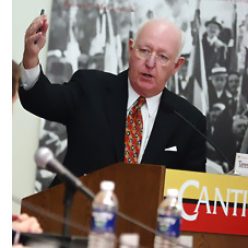Annapolis, I’ve come to discover, affords an excellent vantage to view the many machinations of Washington, D.C., aka America’s Entertainment Capital.
Our town is far enough from the Congress and the White House to escape the inside-the-Beltway mindset, yet close enough to get a sense of what’s going on.
From Annapolis, we’ve been treated so far to the first six months of the Republican-led 114th Congress. Senate Majority Leader Mitch McConnell of Kentucky promised last November that he would convert the upper chamber from what he derided as a Democratic cave of winds into a productive, GOP-administered body that gets things done.
Instead, McConnell has been thwarted repeatedly by Sen. Ted Cruz, R-Texas, and his tea party faction, who have delayed some important priorities (fast-track trade legislation,) derailed others and denounced the proposed nuclear agreement with Iran.
In the House, Speaker John Boehner, R-Ohio, has been grappling with a continuing rebellion from the right that forces vote after fruitless vote against Obamacare, seeks to defund Planned Parenthood and rails against the Export-Import Bank as corporate welfare. (Of course it is corporate welfare for big companies like General Electric and Boeing, which employ thousands of workers. But it keeps us competitive with the 63 other nations that have and use similar financing authority to stimulate exports.)
Most frustrating has been Congress’ inability to provide long-term funding for the nation’s crumbling transportation infrastructure. While Congress has fiddled, desperately needed, job-producing projects to upgrade our highways, bridges and tunnels have stalled. The best Congress could produce was another three-month continuing resolution and a promise to revisit the issue in the fall.
All this obstructionism is exhausting work. So the House and Senate have embarked on a 39-day summer recess. It is no vacation, mind you. Nancy Pelosi, D-California, the House minority leader, and six of Democratic her colleagues immediately boarded a military jet for Kiev, to show support for the beleaguered people of Ukraine.
But, as Al Kamen helpfully pointed out in his “In The Loop” column in The Washington Post, they are taking the scenic route to the war-torn country, via Rome, Naples and Milan, all of which are lovely at this time of year.
From Annapolis, we can recognize this junket for what it is: an all-expenses-paid vacation. But for the record, Congress defines it as part of its August “work period.”
In the interest of governmental efficiency, I am tempted to suggest that Congress stay out of town longer. Say, a couple of years. But I realize the problem: The government would shut down altogether on Sept. 30 for lack of funds. Then the national parks would have to close and the animals in the National Zoo might go hungry.
The Annapolis City Council has taken a page from Congress, going on its own, albeit shorter, summer break. But the business of government grinds slowly on: Last week Mayor Mike Pantelides signed a 20-year lease for the Annapolis Renewable Energy Park, which will become the nation’s largest solar energy project in an unused landfill. Eventually, the 16.8 megawatt solar voltaic installation will offset greenhouse gas emissions and benefit the Chesapeake Bay. It’s a real accomplishment, even if the proposal dates back to Mayor Ellen Moyer’s administration.
So, maybe the Congress could take a page from Annapolis and shorten its vacation and endorse President Barack Obama’s sweeping carbon-cutting proposal, known as the Clean Power Plan. That’s not likely, of course, because the Senate’s top Republicans have already come out against it and 14 states have joined in a lawsuit seeking to block it. Don’t hold your breath on that one.
Still, some things do eventually get accomplished. I think we all know that after all the Senate hearings on the proposed nuclear deal with Iran have been held, and all the attacks from the roster of Republican presidential candidates have been heard, the dealt will likely be approved and go into effect, if only because Obama has vowed to veto any congressional vote to block it and because all the alternatives to the deal are far worse.
I’m not sure Winston Churchill had the U.S. Congress – or Annapolis – in mind when he famously said: “Democracy is the worst form of government, except for all the others.” But he had it right.
Terence Smith is a journalist who lives in Eastport. He can be reached at terencefsmith@verizon.net
